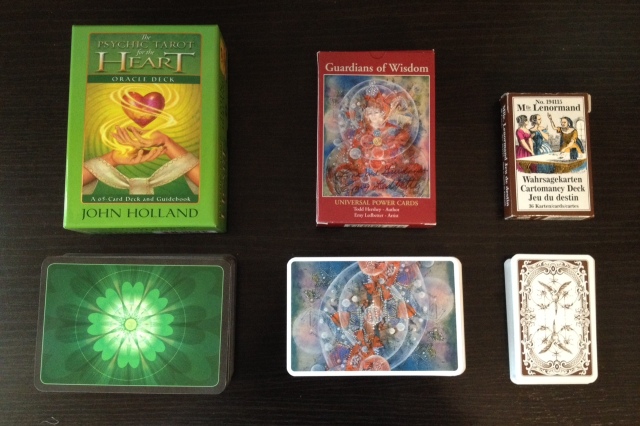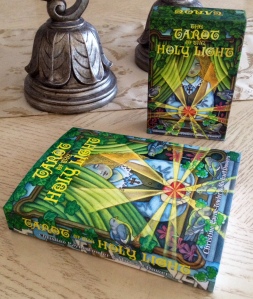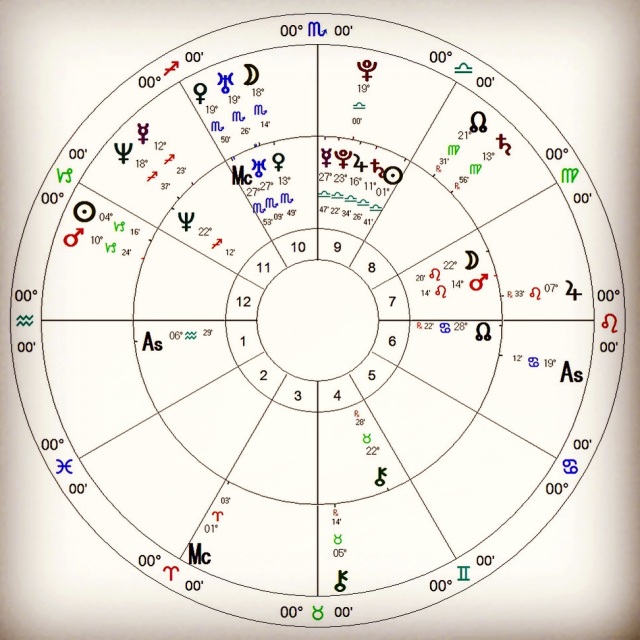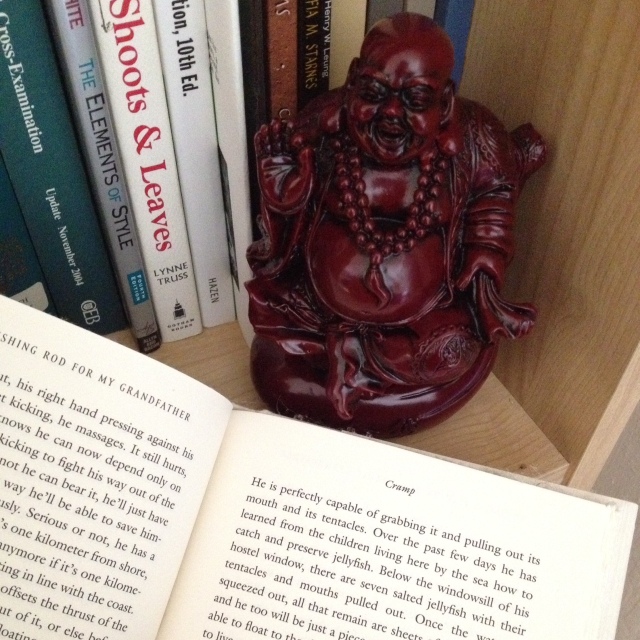
I came across this tag on Greylady’s Hearth a while back and wanted to pipe in with my own post. It originated among the vlogs, like Kelly’s of The Truth in Story and Divinationary, among others.
First of all, it needs to be said upfront that I’m an Air sign, both sun and rising, and my birth chart is dominated by the presence of Air. I’m fickle and flighty and am always changing my mind. So the most I can say is I’m answering these prompts based on me right now and only right now. Ask in, gosh I don’t know, a year or heck maybe even next month and my answer could change. So there’s that.
Nonetheless, let’s give it a go.
3 Favorite Tarot Decks
I’m naming my 3 personal favorite decks, not my go-to public reading decks. While I do use some of the decks I’m about to name in professional reading situations, I am far more likely to go with a Rider-Waite-Smith (such as the Smith-Waite Centennial or just the Rider Waite 1971) or the Golden Universal (basically RWS). Every once in a while, a seeker’s energy pulls me toward an entirely different deck, so it’s hard for me to give absolutes here. However, generally speaking, my favorite go-to reading deck for others is going to be a straightforward, classic RWS deck and from time to time, a TdM (Tarot de Marseille). There are a multitude of reasons for this discrepancy between personal favorites and public reading favorites, but that may be for another blog entry.
Anyway, my 3 personal favorite decks are the Haindl Tarot by Hermann Haindl, the Tarot of the Holy Light by Christine Payne-Towler and Michael Dowers, and the Hermetic Tarot by Godfrey Dowson. When reading for myself on significant matters, one of these three decks will be the tarot deck I reach for. Also, I’m naming the 3 favorite decks in no particular order of favoritism or priority.

Haindl Tarot
Note that the correspondences that these three decks go by don’t necessarily mirror my personal approach (my personal approach is memorialized in my book Holistic Tarot). Just because someone doesn’t agree with my own correspondences doesn’t mean I dismiss or even pass on their deck. Analytically I don’t agree with all the I Ching hexagram correspondences in the Haindl Tarot but by adjusting my frame of mind, intuitively I can work very well and quite effectively with the hexagram divinations that these cards provide. I reviewed the Haindl on this blog and in that review you can see where else I diverge from Mr. Haindl.
There are also two companion books by world renowned tarot expert Rachel Pollack, which I highly recommend if you’ll be working with the Haindl. The volumes are split between the Majors and Minors.

Tarot of the Holy Light
The Tarot of the Holy Light is a deck after my own heart. Again, many of the astrological correspondences differ from my personal approach, but that’s a non-issue to me. When I use Payne-Towler’s deck, I adopt her system of correspondences and have had it work fantastically. I love this deck for its rich esoteric symbolism. The symbols and my intuitive associations with the symbolism help me to mine out the information I need in a reading. Also, the artwork speaks to me.
You can read my review of the Tarot of the Holy Light here and also my review of the first volume of companion books to go with the deck, Tarot of the Holy Light: A Continental Esoteric Tarot (Noreah/Brownfield Press, 2016).

Hermetic Tarot
Finally there is the Hermetic Tarot, one of my first decks. It wasn’t my first, but definitely up there, acquired during the early years. Again, like the Tarot of the Holy Light, the bold, detailed artwork speaks to me. I love pen and ink drawings. There is something intimate about the medium, something about it that immediately synthesizes my analytical side with my intuitive. Old review of it here.
You’ll find several commonalities among the three decks. All three decks include astrological correspondences, even if they may differ with each other as systems and differ with the correspondences I grew up learning and adopting. However, those glyphs are trigger points for my intuition and draw in my work with Western astrology. All three also incorporate Kabbalistic teachings. The Tarot of the Holy Light and the Hermetic are dense with detailed symbolism that I rely on during readings. The artwork in the Haindl Tarot differs from the style of the other two named decks, but it goes the extra mile with the I Ching hexagram and Anglo-Saxon runic correspondences.

I’ve pulled out the Ace of Cups from each of the 3 decks as a sample for the deck, but now in retrospect, it wasn’t the right card for sampling. The Haindl Ace of Cups doesn’t depict the glyphs that the other cards in the deck have. However, the linked deck reviews will show a much wider sampling for each deck, so I guess I’m not too concerned.

3 Favorite Oracle Decks
Okay, this may get controversial, I don’t know yet. I’m going to name as my 3 favorite oracle decks the following (again, in no particular order): the Psychic Tarot for the Heart by John Holland, the Guardians of Wisdom (Tarot) Universal Power Cards by Todd Hershey and illustrated by Emy Ledbetter, and Piatnik’s Mlle. Lenormand Cartomancy Fortune Telling Deck.

Psychic Tarot for the Heart
The Psychic Tarot is marketed as a tarot deck, though it’s comprised of 65 cards rather than the standard 78 card structure of tarot. It is a deck heavily inspired by the structure and the spirit of tarot divination, adopting many of the textbook meanings for the Majors and throughout the Minors. There are distinct differences, however, which I get into in my deck review here. Thus, personally, I consider the Psychic Tarot to be an oracle deck, not tarot.
This oracle deck has to be included as one of my favorites because it’s so eerily accurate. I can ask mundane questions and it will offer me a pithy, spot-on, no-nonsense reply. I highly recommend getting this deck for your personal use.

Guardians of Wisdom
The Guardians of Wisdom Universal Power Cards is considered by most practitioners to be a tarot deck because it follows the 78-card structure of tarot, with each card staying close to the traditional meanings ascribed to each tarot card. While the artwork is magnificent, I don’t find that, by itself, the artwork functions as a tarot deck where I might see a single overflowing chalice on the Ace of Cups (or even One of Hearts as it is named here, or One of Goddesses, as the Heart suit is also referred to as the Goddesses suit) or eight distinct rods of some sort in the Eight of Wands (or Eight of Clubs).
To me, the deck by its construction compels the practitioner to rely on the keywords and the key phrases on the cards, with the artwork seeming to play a more supportive role to the keywords. I talk a bit about why I consider this deck an oracle deck rather than tarot here in my review of the Guardians of Wisdom Universal Power Cards.
I adore this deck as a personal oracle reading deck because of the keywords and key phrases. The card pulled always seems to align synchronistically with what I’m feeling, thinking, and tell me exactly what I need to hear to advance forward in an affirmative way. The art, too, is lovely, and inspires visions. Again, like the Psychic Tarot for the Heart, I like to use it for answering mundane or day-to-day questions.

The Piatnik Lenormand
These days, given the popularity of Lenormands, most tarot practitioners consider Lenormand cards to be their own category and separate it out from the broader term “oracle deck.” That’s why I’m a bit nervous this categorization I’ve opted for may be controversial. These days, Lenormands are Lenormands, not mere “oracle decks.” However, since I never got that into Lenormands specifically (always a tarot girl at heart), I categorize Lenormands under oracle decks, just as I would any decks based on the I Ching hexagrams, which are nearly always 64 cards, or mah jong divination cards. I don’t create a separate category for I Ching oracle decks even though I’m super into pretty much any I Ching based oracle deck out there. (Interestingly, not a single I Ching oracle deck made it onto my list of favorites.)
Piatnik’s Mlle. Lenormand Cartomancy Fortune Telling Deck is just an easy, fantastic Lenormand deck to work with. I haven’t reviewed the deck on my blog yet, but it was the star of the show in my post about Lenormand readings here. In professional reading settings, like the other named oracle decks, I may opt to pull out my Piatnik Lenormand to conclude a tarot reading with a quick 3-card, 5-card, or 9-card Lenormand reading. A quick not-the-Grand-Tableau Lenormand reading can give a seeker concrete, almost always predictive insights into specific individuals or events to take place that a seeker might want a heads up on.
The above photograph is a head to head comparison of the Ace of Cups equivalent in each deck, err, sort of. I wouldn’t say Card 28, The Gentleman in the Lenormand is an Ace of Cups equivalent, though it does correspond with the Ace of Hearts, as does the Rapture card in the Suit of Goddesses in the Guardians of Wisdom (you’ll see the corner notation for the 1 of Hearts).
I referred to my oracle deck selections as “controversial” because the Holland deck is marketed as a tarot deck but doesn’t follow the traditional structure of tarot; the Guardians of Wisdom deck is marketed as “power cards” but follows the traditional structure, though in terms of interpretive approach, seems to rely more on the keywords and verbiage than the illustrations; and the Piatnik Lenormand is a Lenormand deck, which many practitioners would consider to be in a separate category all its own. However, I’ve opted to refer to these three decks as oracle cards.
3 Favorite Other Forms of Divination [Used in Conjunction with Tarot/Oracle]
I’m not sure if that last condition I’ve put in brackets is part of the original tag, but I’m adding it to keep some cohesiveness to the exercise. I’m going to be addressing other forms of divination that I tend to use in conjunction with a tarot reading. Tarot and palmistry, for example, often go hand in hand for professional readers (doh, see what I did there?). My late uncle on my mother’s side was really into palmistry and would read everybody’s palms. He was pretty good at it, to be fair, but I never got that into the practice. Anyway, here are my three: I Ching divinations with coins (I use other methods when divining with just the I Ching and not using it in conjunction with tarot), horary astrology, and bibliomancy (even though the I Ching is a form of bibliomancy, I believe that it deserves to be a separate divination category).
I Ching Divination with Coin Tosses
I have my own personal book of the I Ching I’ve translated and annotated on my own, so I don’t use any known published texts. (I say that because people always ask which English version of the I Ching I use. None. I use my own.) Specifically, I like to use 3 coins I inherited from my maternal grandmother, pictured above. I like to store it with a piece of malachite in that wood figurine drawer thing you see. The wood figurine drawer thing is from the Hubby, a gift he received once upon a time from his maternal grandmother. The figurine is of a crane, symbolic of longevity or immortality, holding a lantern in its beak. There was something very Key IX: The Hermit about it, so I keep it close to my tarot things.
Horary Astrology (or Synastry Chart Analysis)
Okay, the above photo is not of a horary chart. It’s a synastry chart, but it was the astrological chart I had the quickest access to in the moment, so up it went as companion illustration for this blog post. It still works, though, since I do synastry chart analyses for love and relationship readings.
I will often note the exact date, time, and location for a tarot reading I am doing and construct an astrological chart for that moment. I’ll then interpret that chart in a divinatory manner for answering the seeker’s question at hand. Horary astrology, I suppose like I Ching, is very much an exercise of synchronicity.
Bibliomancy
I got into bibliomancy in a very amateur, unstructured way as a kid. Before I even knew it was a “thing,” that it was actually a form of divination that some Christians will use, when I grew antsy sitting in one of the pews at church, I’d pull out the Bible, close my eyes, flip to a random page, drop my finger, and look to see what passage I landed on, and pretend that the exercise held some sort of woo-woo meaning. (And apparently, this is a thing. People really do this as a legit form of bibliomancy.)
The aforesaid personal amateur, unstructured form of bibliomancy developed from that into pulling any book off my many shelves full of books, opening to any page, and dropping my index finger on a random sentence, with the conviction that the sentence I land on holds an answer.
I had grown up surrounded by books. Literally. As a kid in the first house my parents bought, we weren’t well off just yet and they were fresh immigrants, so rooms had to be multi-purpose. My “bedroom” as a wee one was also my father’s den, and so it contained all the books from his university and doctoral years. At age 5, instead of having a room of colorful plastic Playskool paraphernalia, I had the Encyclopedia of Physics, volumes I to (what felt like) a billion. When we moved into a bigger house and I had my own room, the four walls of that bedroom were lined with shelves and cases full of books. Add an innate fascination with the metaphysical and dabbling with bibliomancy becomes a no-brainer.
Like the use of oracle cards, sometimes I will end a tarot divination by going to one of my books in my library, turning to any random page, and read a sentence off that page. Let’s do one right now! Using the book that happens to be right here by my computer…
“As explained by NASDAQ, this provides a company at least 180 days to cure noncompliance and would typically allow a company to regain compliance in connection with its annual meeting.”
Hmm. Okay. So it doesn’t always work… Usually for bibliomancy, I’ll draw from a Holy Book or a classic work of fiction, not a U.S. securities law treatise.
What are your responses the 3x3x3 tarot divination inquiry?







Reblogged this on ravenhawks' magazine and commented:
Very interesting, I have never thought about my favorite go to divination methods in those terms.
LikeLike
This is a treasure of a post and an answered prayer! While reading your book and blog I’ve often wondered the very same thing: which are your favorite decks, oracles, and divining tools. And here they are! Some are familiar to me, others are new. The new ones are all worth looking into. This is one of those posts I look for in my reading time. I’m going to pour myself a cup of tea, and savor each word. Just one quick question: I see you use the I Ching with coins in the traditional way. When I consult the I Ching, I use the Tao Oracle with surprising results. Have you? Do you? And if so, any insight as to how you use it? Thank you ever so much!
LikeLike
Yes, I love the Tao Oracle and I’m not surprised in the least that it would yield great results. For me, though, I do prefer using coins or rice grains to cast my I Ching hexagrams. 🙂
Also, these are my “favorites” at this moment. Libra, remember. I’m a huge flake. 😀
LikeLiked by 1 person
Reblogged this on Taroteer and commented:
This is a treasure of a post and an answered prayer!
While reading Benebell Wen’s Holistic Tarot and her blog I often wondered which are her favorite Tarot decks, divining oracles, and divination tools. Ask a question and the universe will answer. Today, on her very excellent blog Ms. Wen answers all those questions and some more. In a post worthy of a cup of tea or two, she shows and explains what some of her favorite Tarot decks are. Along with photos of the decks and oracles, she serves a generous post every Tarot enthusiast will appreciate. Some of the decks are familiar to me, others are new. The new ones are all worth looking into. This is one of those posts I look for in my reading time. So I’m going to pour myself a cup of tea, and savor each word. Enjoy!
LikeLike
A delightful read as always, Benebell. But I’m surprised to see that your favorite decks are so heavily Qabalistic. (Or Cabalistic, or Kabbalistic, or, well, you get the idea.) I’d be curious to know how you work with this symbolism, since (unless I’m really off my rocker today) you’ve mentioned previously that Qabalah isn’t really your thing.
LikeLike
I do work with some Kabbalistic symbolism and I’m definitely interested in learning a rudimentary foundation in the Kabbalah, but you’re right– it’s not my “thing.” Personally, I’ve found these specific tarot decks have been created in such a way that I do believe you can come at any of them with your own personal set of symbolic correspondences and get a lot out of these cards.
LikeLiked by 1 person
Oh marvellous blog, Benebell! Thanks for sharing. Wish you lived next door so much! 🙂
LikeLike
It would be a ball if we lived next door to each other!!
LikeLike
🙂 And the example horary astrological chart is quite interesting, too. Stelliums, wow!
LikeLike
This is so fun Im going to have to play along~ 🙂 Thanks for sharing!
LikeLike
Yes! Please do!! Can’t wait to read!
LikeLike
Thank u!
LikeLike
Have you read ‘ Divination – sacred tools for reading the mind of God?’ Its good stuff, by paul o brien.
LikeLike
This article you just wrote is so inspiring, i love the box u stored your IChing coins, i wished i had kept some leftover real coins from my Dad who came from China back in the 1940s….
LikeLike
Pingback: Guardians of Wisdom | Inquietudes
Pingback: Guardians of Wisdom | Taroteer
Pingback: Guardians of Wisdom | OMPawo
It seems to me that securities tomes could work for bibliomancy. The opportunity to cure is surely something that we all seek when we err, but one that must be acted upon diligently. As is the case for all of our work, mundane and esoteric. Only you can know if there was something in the last 180 days that required your attention at that time. I know that the answer would be yes for me, at any time.
This was fascinating to read. I’m glad that you are a writer, I do like to read an indepth blog post. I also enjoy the vlogs, but there’s something about the written word and a thorough analysis that is extremely satisfying.
LikeLike
lol – I also tried some bibliomancy before I knew it was a “thing”. But honestly it never gave me any useful results (no matter the type of book).
As funny and weird as it may sound, but what really does work for me is TV-mancy or radiomancy…
If I send out my intention that the next song on the radio or today’s episode of my TV shows (I don’t keep track of those I already watched a hundred times – so it’s always a surprise) tells me something important – it does.
LikeLike